構築4グラフィック:宇宙の大きさは半径138億光年か。宇宙は光速で膨張しているのか。
小阪淳
Is the size of the universe a radius of 13.8 billion light-years? Is the universe expanding at the speed of light?Jun Kosaka
宇宙的大小是半径138亿光年。宇宙是否以光速膨胀?


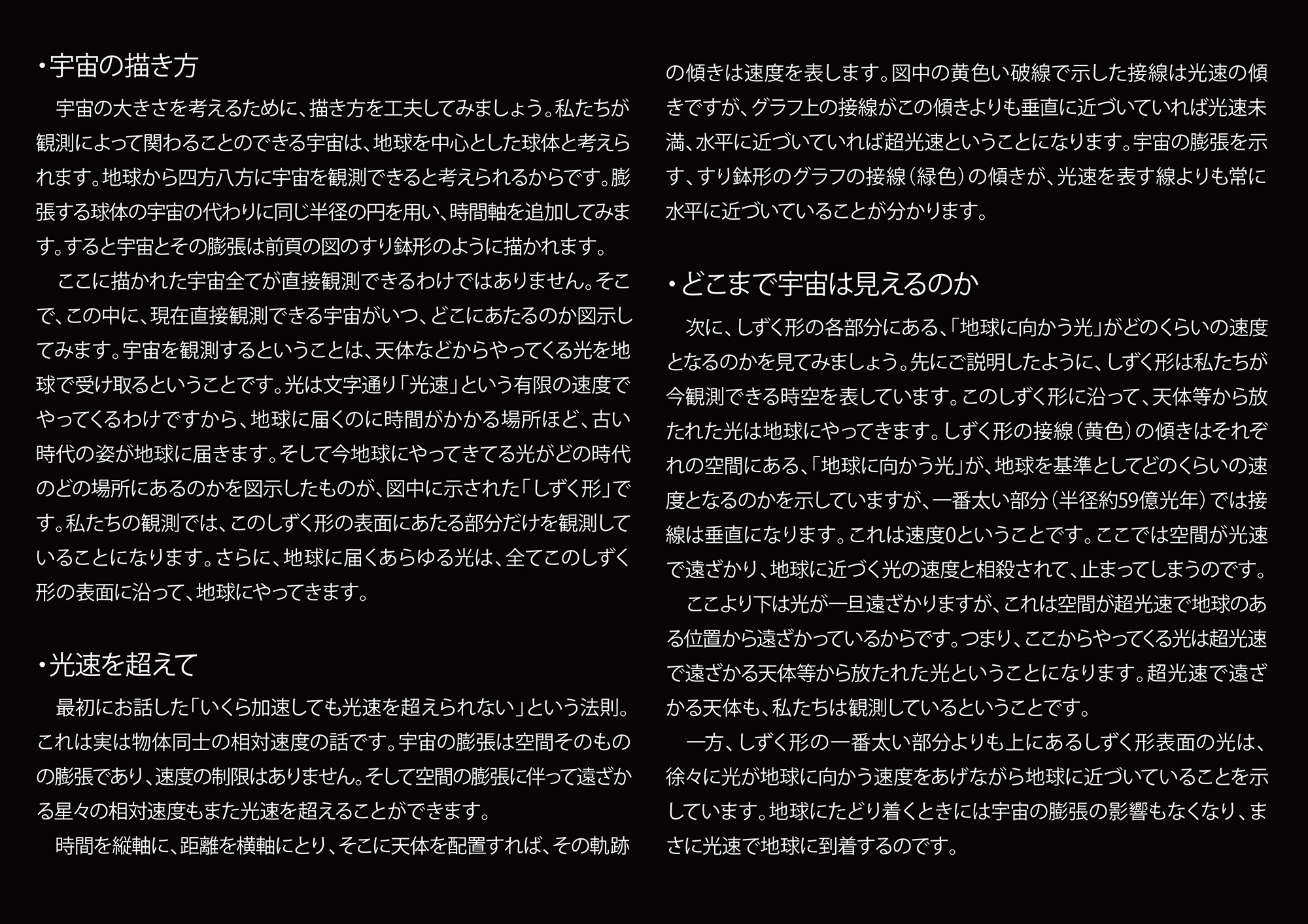

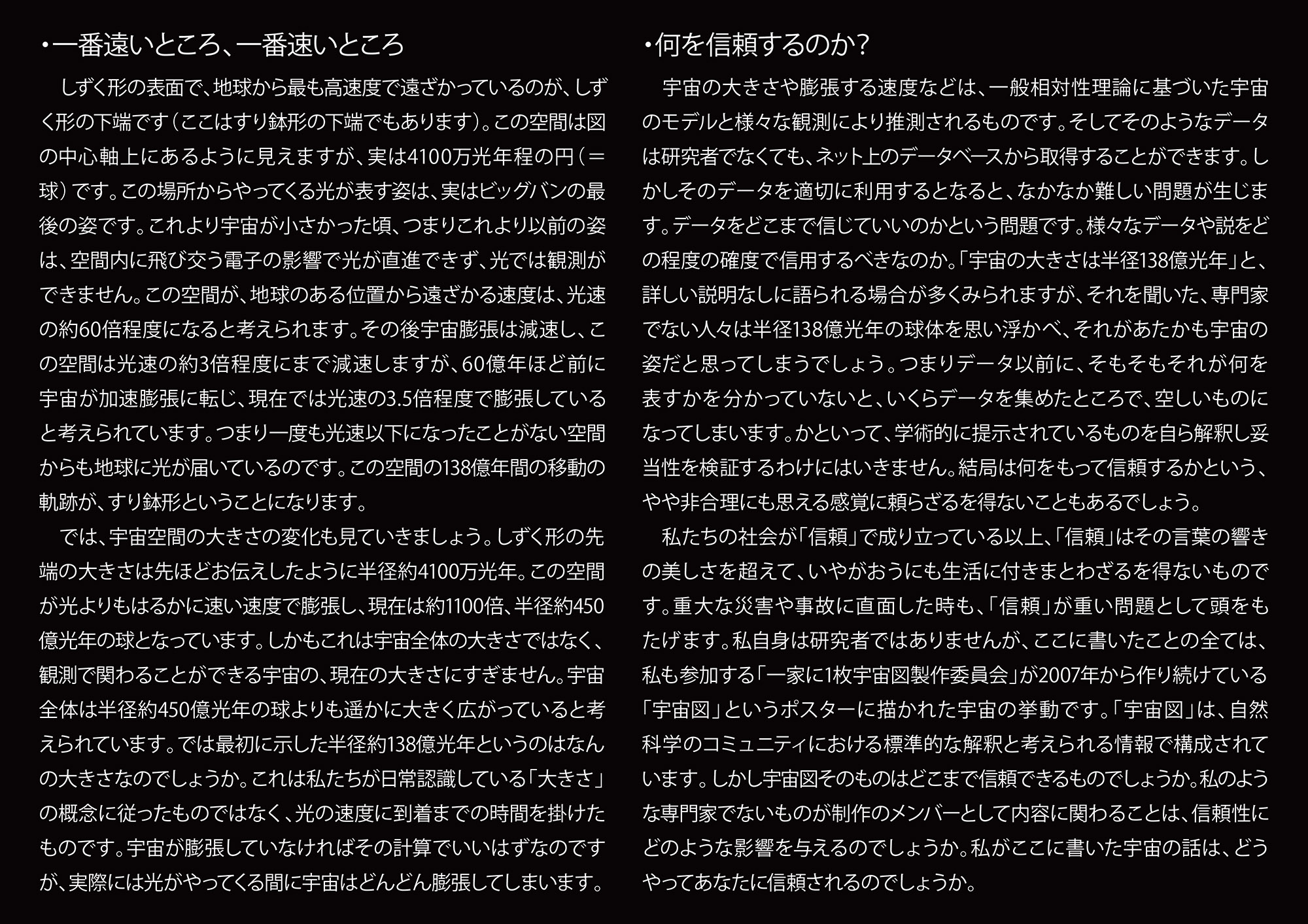
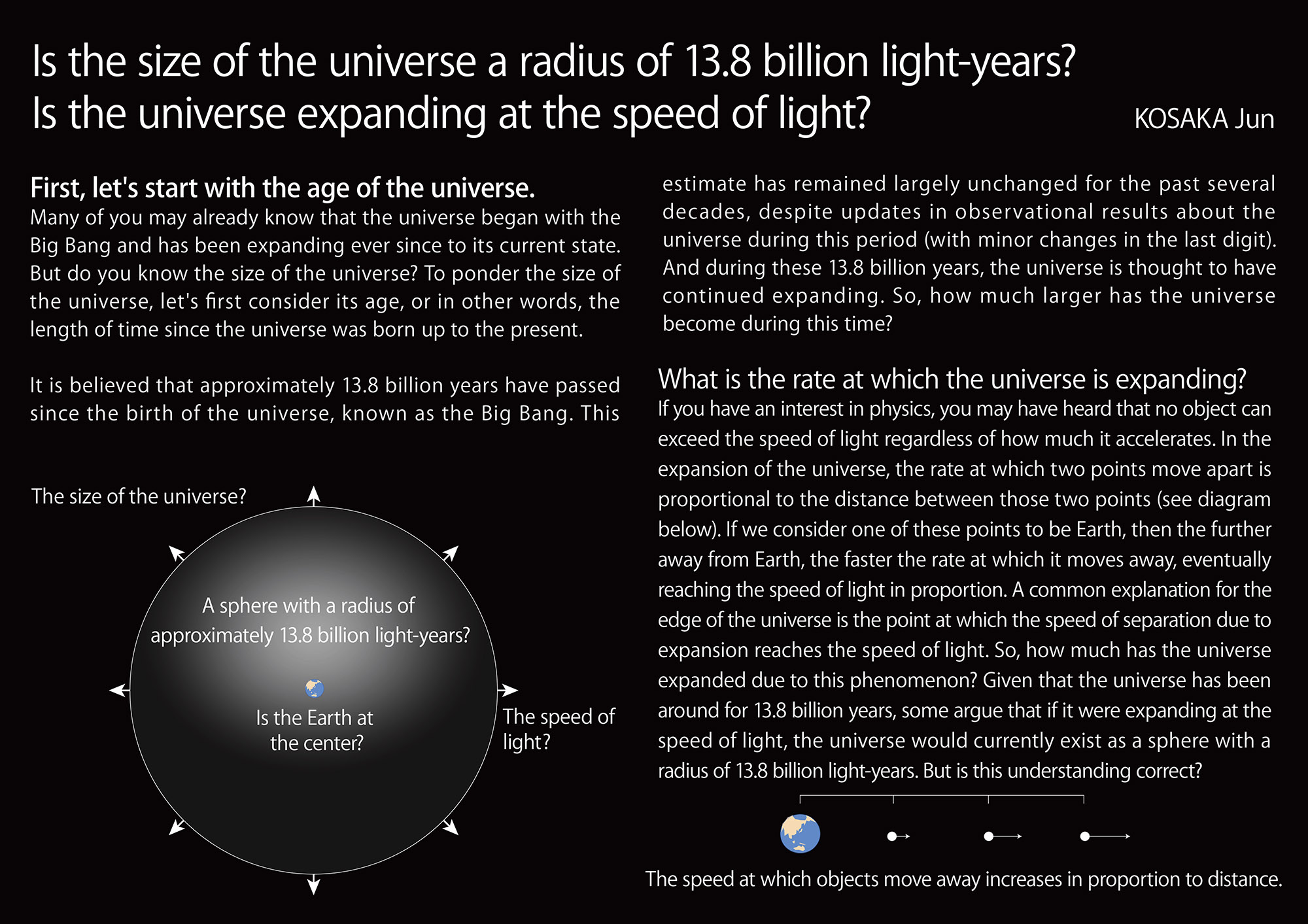

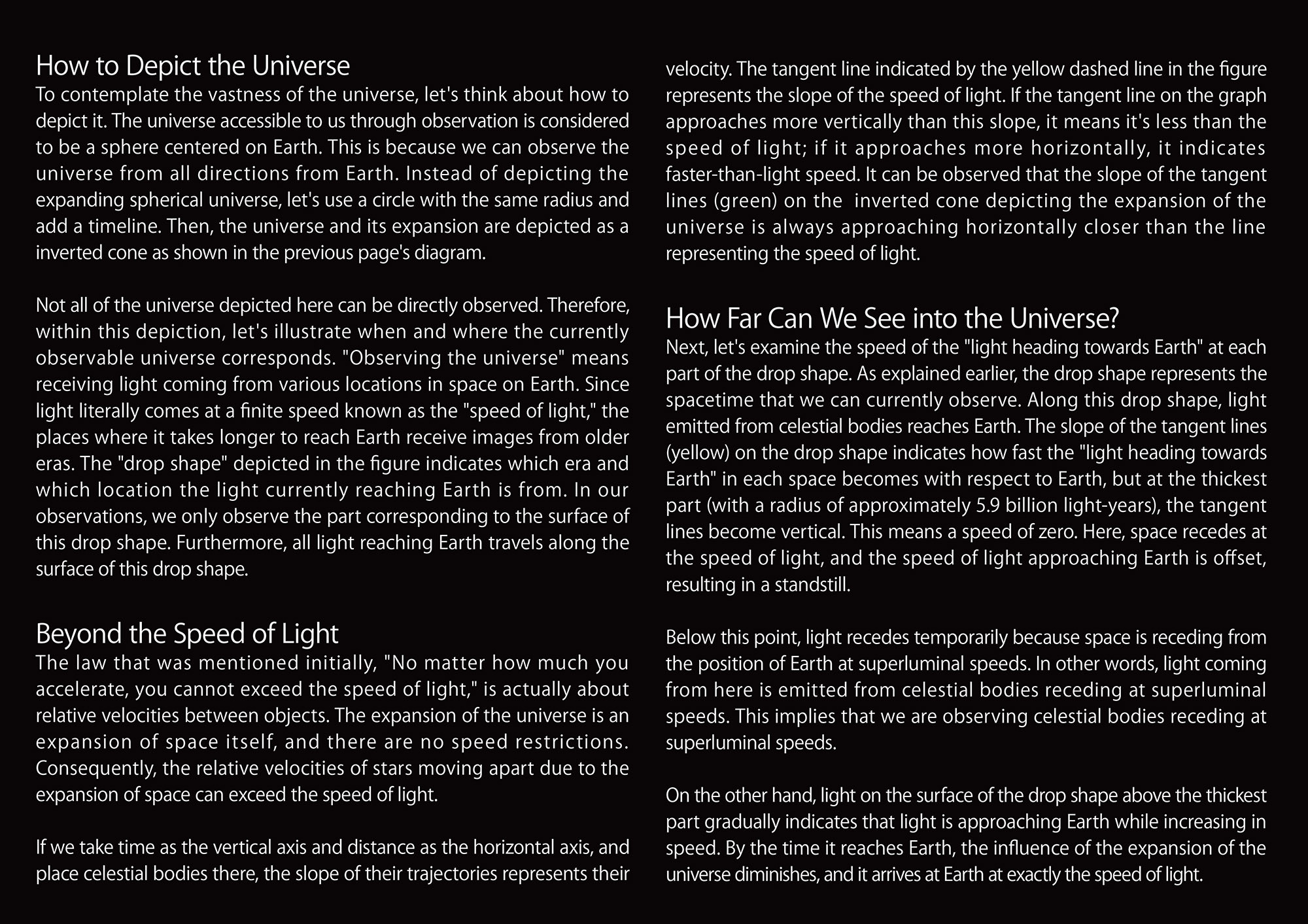
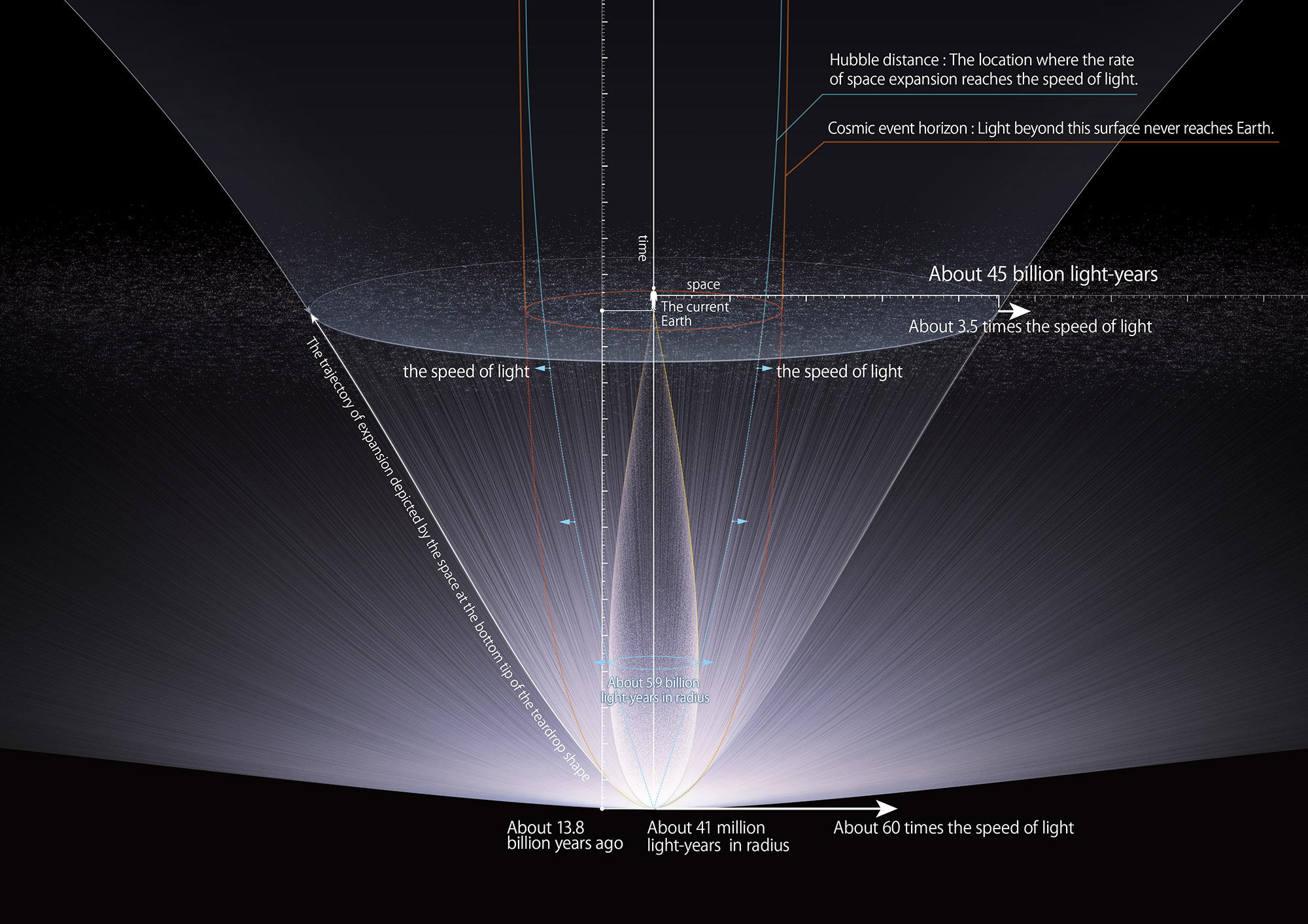
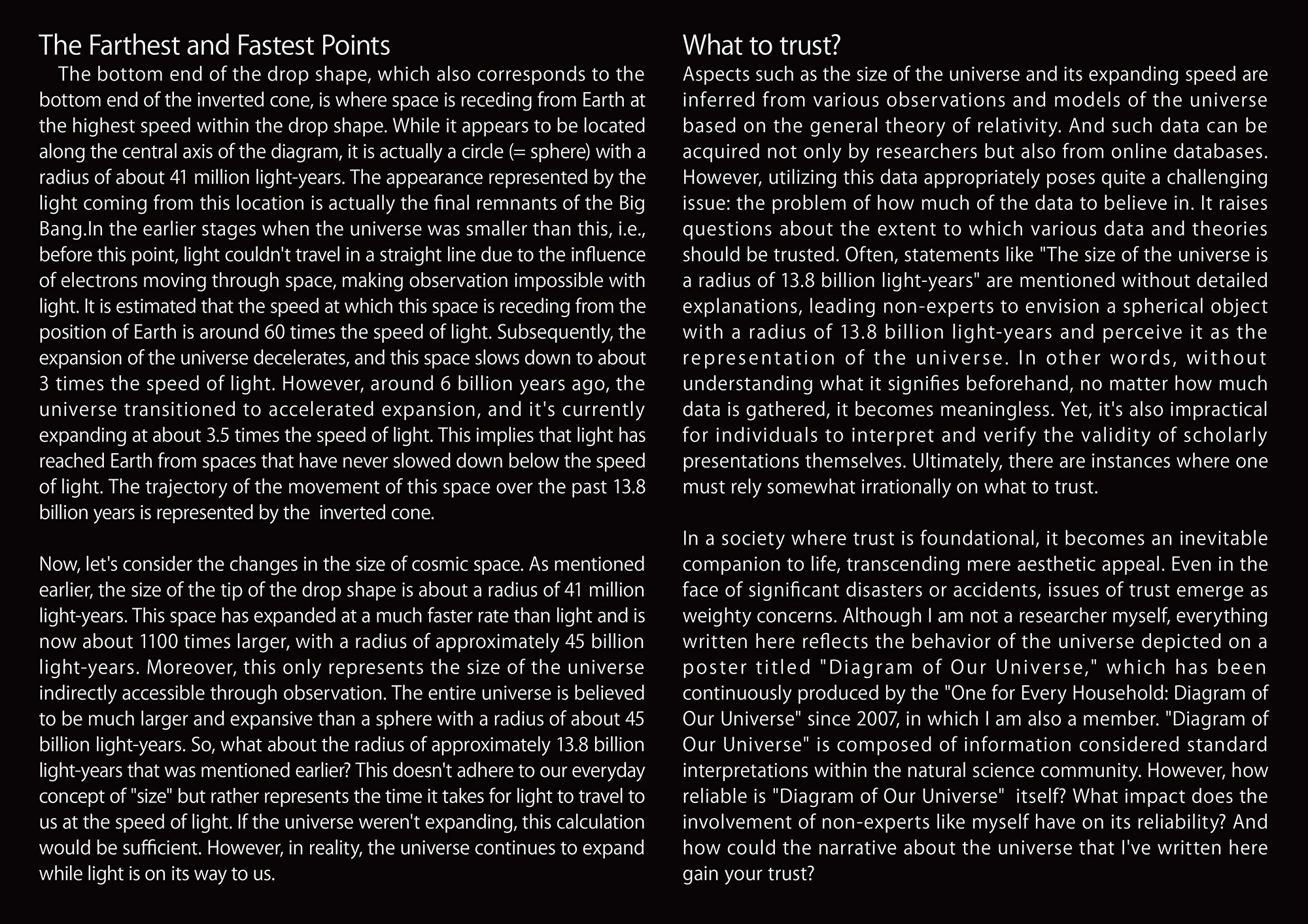
宇宙の大きさは半径138億光年か。宇宙は光速で膨張しているのか。
●まずは宇宙の年齢から
宇宙はビックバンから始まり、膨張して今の宇宙があるということをご存知の方は多いでしょう。では宇宙の大きさはご存知でしょうか。ここで宇宙の大きさを考えてみたいと思いますが、大きさを考えるために、まずは宇宙の年齢、つまり宇宙が生まれてから現在に至るまでの時間の長さを確認してみます。宇宙はその誕生であるビッグバンから、現在約138億年が経過していると考えられています。この推測値は、この十数年ほどの宇宙の観測結果の更新でもほぼ変化していません(下一桁の数字が若干変わる程度)。そしてこの138億年の間、宇宙は膨張し続けていると考えられています。ではその間に宇宙はどれほど大きくなったのでしょうか。
●宇宙が膨張する速度は?
物理学に興味がおありな方なら、物体はどんなに加速しても光速を超えることはできないという話を聞いたことがあるのではないでしょうか。宇宙の膨張では、ある2点間の遠ざかる速度は、その2点間の距離に比例します(下図)。2点のうちの一つを地球とすれば、地球から遠いほど、比例して遠ざかる速度は速くなり、いずれは光速に達してしまいます。宇宙の果ての説明でよく語られるのは、この、膨張によって遠ざかる速度が光速の場所というものです。ではこの膨張により宇宙はどこまで大きくなったでしょうか。宇宙が生まれて138億年経つのだから、光速で膨張していれば宇宙は半径138億光年の球体として現在存在しているといわれることもあります。果たしてこれらは正しい理解でしょうか。
●宇宙の描き方
宇宙の大きさを考えるために、描き方を工夫してみましょう。私たちが観測によって関わることのできる宇宙は、地球を中心とした球体と考えられます。地球から四方八方に宇宙を観測できると考えられるからです。膨張する球体の宇宙の代わりに同じ半径の円を用い、時間軸を追加してみます。すると宇宙とその膨張は前頁の図のすり鉢形のように描かれます。
ここに描かれた宇宙全てが直接観測できるわけではありません。そこで、この中に、現在直接観測できる宇宙がいつ、どこにあたるのか図示してみます。宇宙を観測するということは、天体などからやってくる光を地球で受け取るということです。光は文字通り「光速」という有限の速度でやってくるわけですから、地球に届くのに時間がかかる場所ほど、古い時代の姿が地球に届きます。そして今地球にやってきてる光がどの時代のどの場所にあるのかを図示したものが、図中に示された「しずく形」です。私たちの観測では、このしずく形の表面にあたる部分だけを観測していることになります。さらに、地球に届くあらゆる光は、全てこのしずく形の表面に沿って、地球にやってきます。
●光速を超えて
最初にお話した「いくら加速しても光速を超えられない」という法則。これは実は物体同士の相対速度の話です。宇宙の膨張は空間そのものの膨張であり、速度の制限はありません。そして空間の膨張に伴って遠ざかる星々の相対速度もまた光速を超えることができます。
時間を縦軸に、距離を横軸にとり、そこに天体を配置すれば、その軌跡の傾きは速度を表します。図中の黄色い破線で示した接線は光速の傾きですが、グラフ上の接線がこの傾きよりも垂直に近づいていれば光速未満、水平に近づいていれば超光速ということになります。宇宙の膨張を示す、すり鉢形のグラフの接線(緑色)の傾きが、光速を表す線よりも常に水平に近づいていることが分かります。
●どこまで宇宙は見えるのか
次に、しずく形の各部分にある、「地球に向かう光」がどのくらいの速度となるのかを見てみましょう。先にご説明したように、しずく形は私たちが今観測できる時空を表しています。このしずく形に沿って、天体等から放たれた光は地球にやってきます。しずく形の接線(黄色)の傾きはそれぞれの空間にある、「地球に向かう光」が、地球を基準としてどのくらいの速度となるのかを示していますが、一番太い部分(半径約59億光年)では接線は垂直になります。これは速度0ということです。ここでは空間が光速で遠ざかり、地球に近づく光の速度と相殺されて、止まってしまうのです。
ここより下は光が一旦遠ざかりますが、これは空間が超光速で地球のある位置から遠ざかっているからです。つまり、ここからやってくる光は超光速で遠ざかる天体等から放たれた光ということになります。超光速で遠ざかる天体も、私たちは観測しているということです。
一方、しずく形の一番太い部分よりも上にあるしずく形表面の光は、徐々に光が地球に向かう速度をあげながら地球に近づいていることを示しています。地球にたどり着くときには宇宙の膨張の影響もなくなり、まさに光速で地球に到着するのです。
●一番遠いところ、一番速いところ
しずく形の表面で、地球から最も高速度で遠ざかっているのが、しずく形の下端です(ここはすり鉢形の下端でもあります)。この空間は図の中心軸上にあるように見えますが、実は4100万光年程の円(=球)です。この場所からやってくる光が表す姿は、実はビッグバンの最後の姿です。これより宇宙が小さかった頃、つまりこれより以前の姿は、空間内に飛び交う電子の影響で光が直進できず、光では観測ができません。この空間が、地球のある位置から遠ざかる速度は、光速の約60倍程度になると考えられます。その後宇宙膨張は減速し、この空間は光速の約3倍程度にまで減速しますが、60億年ほど前に宇宙が加速膨張に転じ、現在では光速の3.5倍程度で膨張していると考えられています。つまり一度も光速以下になったことがない空間からも地球に光が届いているのです。この空間の138億年間の移動の軌跡が、すり鉢形ということになります。
では、宇宙空間の大きさの変化も見ていきましょう。しずく形の先端の大きさは先ほどお伝えしたように半径約4100万光年。この空間が光よりもはるかに速い速度で膨張し、現在は約1100倍、半径約450億光年の球となっています。しかもこれは宇宙全体の大きさではなく、観測で関わることができる宇宙の、現在の大きさにすぎません。宇宙全体は半径約450億光年の球よりも遥かに大きく広がっていると考えられています。では最初に示した半径約138億光年というのはなんの大きさなのでしょうか。これは私たちが日常認識している「大きさ」の概念に従ったものではなく、光の速度に到着までの時間を掛けたものです。宇宙が膨張していなければその計算でいいはずなのですが、実際には光がやってくる間に宇宙はどんどん膨張してしまいます。
●何を信頼するのか?
宇宙の大きさや膨張する速度などは、一般相対性理論に基づいた宇宙のモデルと様々な観測により推測されるものです。そしてそのようなデータは研究者でなくても、ネット上のデータベースから取得することができます。しかしそのデータを適切に利用するとなると、なかなか難しい問題が生じます。データをどこまで信じていいのかという問題です。様々なデータや説をどの程度の確度で信用するべきなのか。「宇宙の大きさは半径138億光年」と、詳しい説明なしに語られる場合が多くみられますが、それを聞いた、専門家でない人々は半径138億光年の球体を思い浮かべ、それがあたかも宇宙の姿だと思ってしまうでしょう。つまりデータ以前に、そもそもそれが何を表すかを分かっていないと、いくらデータを集めたところで、空しいものになってしまいます。かといって、学術的に提示されているものを自ら解釈し妥当性を検証するわけにはいきません。結局は何をもって信頼するかという、やや非合理にも思える感覚に頼らざるを得ないこともあるでしょう。
私たちの社会が「信頼」で成り立っている以上、「信頼」はその言葉の響きの美しさを超えて、いやがおうにも生活に付きまとわざるを得ないものです。重大な災害や事故に直面した時も、「信頼」が重い問題として頭をもたげます。私自身は研究者ではありませんが、ここに書いたことの全ては、私も参加する「一家に1枚宇宙図製作委員会」が2007年から作り続けている「宇宙図」というポスターに描かれた宇宙の挙動です。「宇宙図」は、自然科学のコミュニティにおける標準的な解釈と考えられる情報で構成されています。しかし宇宙図そのものはどこまで信頼できるものでしょうか。私のような専門家でないものが制作のメンバーとして内容に関わることは、信頼性にどのような影響を与えるのでしょうか。私がここに書いた宇宙の話は、どうやってあなたに信頼されるのでしょうか。
Is the size of the universe a radius of 13.8 billion light-years?
Is the universe expanding at the speed of light?
●First, let's start with the age of the universe.
Many of you may already know that the universe began with the Big Bang and has been expanding ever since to its current state. But do you know the size of the universe? To ponder the size of the universe, let's first consider its age, or in other words, the length of time since the universe was born up to the present.
It is believed that approximately 13.8 billion years have passed since the birth of the universe, known as the Big Bang. This estimate has remained largely unchanged for the past several decades, despite updates in observational results about the universe during this period (with minor changes in the last digit). And during these 13.8 billion years, the universe is thought to have continued expanding. So, how much larger has the universe become during this time?
●What is the rate at which the universe is expanding?
If you have an interest in physics, you may have heard that no object can exceed the speed of light regardless of how much it accelerates. In the expansion of the universe, the rate at which two points move apart is proportional to the distance between those two points (see diagram below). If we consider one of these points to be Earth, then the further away from Earth, the faster the rate at which it moves away, eventually reaching the speed of light in proportion. A common explanation for the edge of the universe is the point at which the speed of separation due to expansion reaches the speed of light. So, how much has the universe expanded due to this phenomenon? Given that the universe has been around for 13.8 billion years, some argue that if it were expanding at the speed of light, the universe would currently exist as a sphere with a radius of 13.8 billion light-years. But is this understanding correct?
●How to Depict the Universe
To contemplate the vastness of the universe, let's think about how to depict it. The universe accessible to us through observation is considered to be a sphere centered on Earth. This is because we can observe the universe from all directions from Earth. Instead of depicting the expanding spherical universe, let's use a circle with the same radius and add a timeline. Then, the universe and its expansion are depicted as a inverted cone as shown in the previous page's diagram.
Not all of the universe depicted here can be directly observed. Therefore, within this depiction, let's illustrate when and where the currently observable universe corresponds. "Observing the universe" means receiving light coming from various locations in space on Earth. Since light literally comes at a finite speed known as the "speed of light," the places where it takes longer to reach Earth receive images from older eras. The "drop shape" depicted in the figure indicates which era and which location the light currently reaching Earth is from. In our observations, we only observe the part corresponding to the surface of this drop shape. Furthermore, all light reaching Earth travels along the surface of this drop shape.
●Beyond the Speed of Light
The law that was mentioned initially, "No matter how much you accelerate, you cannot exceed the speed of light," is actually about relative velocities between objects. The expansion of the universe is an expansion of space itself, and there are no speed restrictions. Consequently, the relative velocities of stars moving apart due to the expansion of space can exceed the speed of light.
If we take time as the vertical axis and distance as the horizontal axis, and place celestial bodies there, the slope of their trajectories represents their velocity. The tangent line indicated by the yellow dashed line in the figure represents the slope of the speed of light. If the tangent line on the graph approaches more vertically than this slope, it means it's less than the speed of light; if it approaches more horizontally, it indicates faster-than-light speed. It can be observed that the slope of the tangent lines (green) on the inverted cone depicting the expansion of the universe is always approaching horizontally closer than the line representing the speed of light.
●How Far Can We See into the Universe?
Next, let's examine the speed of the "light heading towards Earth" at each part of the drop shape. As explained earlier, the drop shape represents the spacetime that we can currently observe. Along this drop shape, light emitted from celestial bodies reaches Earth. The slope of the tangent lines (yellow) on the drop shape indicates how fast the "light heading towards Earth" in each space becomes with respect to Earth, but at the thickest part (with a radius of approximately 5.9 billion light-years), the tangent lines become vertical. This means a speed of zero. Here, space recedes at the speed of light, and the speed of light approaching Earth is offset, resulting in a standstill.
Below this point, light recedes temporarily because space is receding from the position of Earth at superluminal speeds. In other words, light coming from here is emitted from celestial bodies receding at superluminal speeds. This implies that we are observing celestial bodies receding at superluminal speeds.
On the other hand, light on the surface of the drop shape above the thickest part gradually indicates that light is approaching Earth while increasing in speed. By the time it reaches Earth, the influence of the expansion of the universe diminishes, and it arrives at Earth at exactly the speed of light.
●The Farthest and Fastest Points
The bottom end of the drop shape, which also corresponds to the bottom end of the inverted cone, is where space is receding from Earth at the highest speed within the drop shape. While it appears to be located along the central axis of the diagram, it is actually a circle (= sphere) with a radius of about 41 million light-years. The appearance represented by the light coming from this location is actually the final remnants of the Big Bang.In the earlier stages when the universe was smaller than this, i.e., before this point, light couldn't travel in a straight line due to the influence of electrons moving through space, making observation impossible with light. It is estimated that the speed at which this space is receding from the position of Earth is around 60 times the speed of light. Subsequently, the expansion of the universe decelerates, and this space slows down to about 3 times the speed of light. However, around 6 billion years ago, the universe transitioned to accelerated expansion, and it's currently expanding at about 3.5 times the speed of light. This implies that light has reached Earth from spaces that have never slowed down below the speed of light. The trajectory of the movement of this space over the past 13.8 billion years is represented by the inverted cone.
Now, let's consider the changes in the size of cosmic space. As mentioned earlier, the size of the tip of the drop shape is about a radius of 41 million light-years. This space has expanded at a much faster rate than light and is now about 1100 times larger, with a radius of approximately 45 billion light-years. Moreover, this only represents the size of the universe indirectly accessible through observation. The entire universe is believed to be much larger and expansive than a sphere with a radius of about 45 billion light-years. So, what about the radius of approximately 13.8 billion light-years that was mentioned earlier? This doesn't adhere to our everyday concept of "size" but rather represents the time it takes for light to travel to us at the speed of light. If the universe weren't expanding, this calculation would be sufficient. However, in reality, the universe continues to expand while light is on its way to us.
●What to trust?
Aspects such as the size of the universe and its expanding speed are inferred from various observations and models of the universe based on the general theory of relativity. And such data can be acquired not only by researchers but also from online databases. However, utilizing this data appropriately poses quite a challenging issue: the problem of how much of the data to believe in. It raises questions about the extent to which various data and theories should be trusted. Often, statements like "The size of the universe is a radius of 13.8 billion light-years" are mentioned without detailed explanations, leading non-experts to envision a spherical object with a radius of 13.8 billion light-years and perceive it as the representation of the universe. In other words, without understanding what it signifies beforehand, no matter how much data is gathered, it becomes meaningless. Yet, it's also impractical for individuals to interpret and verify the validity of scholarly presentations themselves. Ultimately, there are instances where one must rely somewhat irrationally on what to trust.
In a society where trust is foundational, it becomes an inevitable companion to life, transcending mere aesthetic appeal. Even in the face of significant disasters or accidents, issues of trust emerge as weighty concerns. Although I am not a researcher myself, everything written here reflects the behavior of the universe depicted on a poster titled "Diagram of Our Universe," which has been continuously produced by the "One for Every Household: Diagram of Our Universe" since 2007, in which I am also a member. "Diagram of Our Universe" is composed of information considered standard interpretations within the natural science community. However, how reliable is "Diagram of Our Universe" itself? What impact does the involvement of non-experts like myself have on its reliability? And how could the narrative about the universe that I've written here gain your trust?
[2024.6.1 UPDATE]
【Issue vol.1】
構築4グラフィックス:ディアスポラのかたち/The Shape of Diaspora and Building Mode 4/构筑4的图形
【Issue vol.2】
構築4グラフィックス:土派/Soilism/土派
【Issue vol.3】
構築4グラフィックス:鉄図/The Big Guide to Iron/铁图
【Issue vol.4】
構築4グラフィックス:ニワカニワ/Niwakaniwa: Improvised Gardens/即兴之庭
【Issue vol.5】
構築4グラフィック:AIエコ画百景/One Hundred Views of Ecology AI Creates/AI生态画百景
【Issue vol.6】
構築4グラフィック:戦争とホビー/War and Hobby/戰爭與愛好
【Issue vol.7】
構築4グラフィック:常温摩擦/Ambient Temperature Friction/常温摩擦
協賛/SUPPORT サントリー文化財団(2020年度)、一般財団法人窓研究所 WINDOW RESEARCH INSTITUTE(2019〜2021年度)、公益財団法人ユニオン造形財団(2022年度〜)



